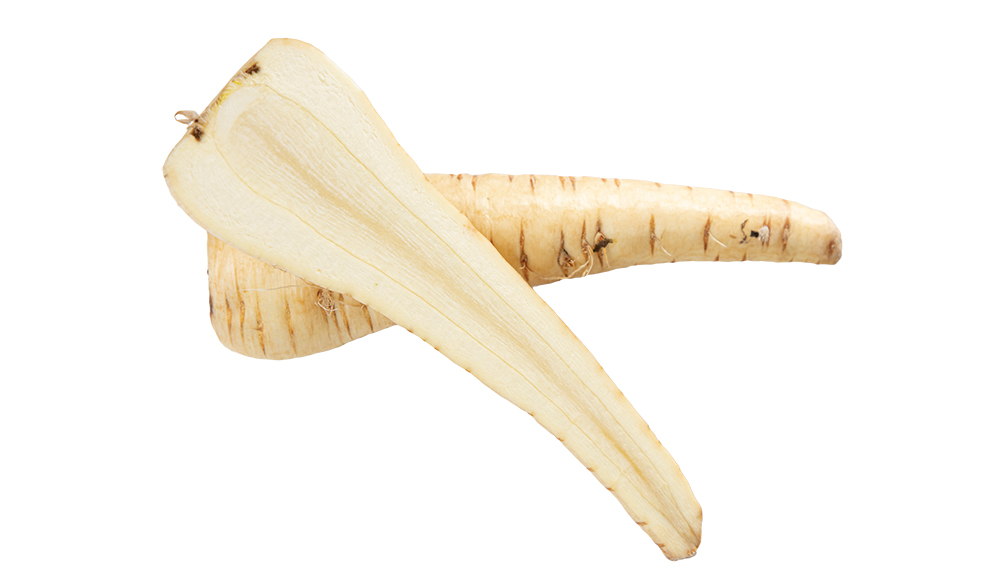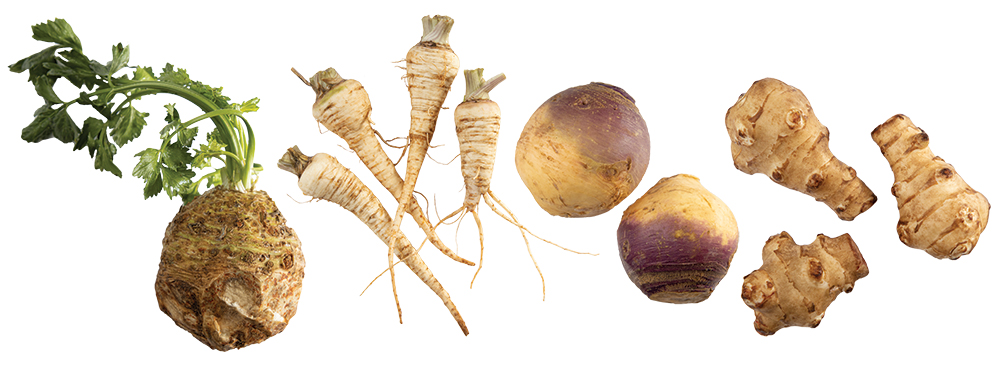 At the restaurant where I’m the executive chef, I’ve had this exchange with new cooks repeatedly over the years: “Please bring me some parsnips.” The cook walks away, and after a lengthy absence returns with a look of bafflement. Experience tells me exactly what to say. “The white carrots.” They return, mission accomplished, “white carrots” in hand.
At the restaurant where I’m the executive chef, I’ve had this exchange with new cooks repeatedly over the years: “Please bring me some parsnips.” The cook walks away, and after a lengthy absence returns with a look of bafflement. Experience tells me exactly what to say. “The white carrots.” They return, mission accomplished, “white carrots” in hand.
Although popular in Europe—almost ubiquitous on the holiday table in England—this elegantly sweet and aromatic root vegetable is still overlooked in our country. I fell in love with it decades ago while living in Germany. They were served as a simple accompaniment to a venison roast, their sweetness and perfume a wonderful counterpoint to the game—comforting and delicious.
For those uninitiated to the parsnip, it indeed looks like a white carrot. It has the vegetal sweetness of the sugariest carrot, but even more so. In fact, it was used as a source of sweetener in Europe when honey was too expensive and sugar cane, a New-World ingredient, was still unheard of. Parsnips are closely related to both carrots and parsley and have a flavor profile that reflects both plants. Like other root vegetables, it is incredibly versatile. It can be thinly sliced or shaved like a carrot and served raw, dressed in a salad. It can be cooked whole or cut in chunks and roasted, or sautéed in butter or oil. Parsnips make a lovely purée, either alone or in combination with other root vegetables. Use their natural sweetness to the advantage of other root vegetables by combining them in a gratin or soup. If their sweetness seems too much, it can be balanced by the addition of potato, lemon juice or zest, the use of smoked meats, capers, or dark leafy bitter greens. If you’re not purchasing parsnips at a farmers market, they are often bagged in random sizes and/or coated in wax (as are a number of root vegetables) to help maintain freshness. Just be sure to peel them thoroughly before using. The issue of random sizes can be corrected by cutting the peeled parsnips into chunks of similar size. The core of the parsnip isn’t usually troublesome, although it can, in extreme cases, be a bit woody. If the cores of larger parsnips look especially fibrous, just cut out the cores before proceeding with the recipe (reserve them to use in broth where their aroma will be appreciated). Whatever your level of parsnip prowess, try the following recipe for your next holiday—or any—get together. It’s extremely simple and delicious.
Parsnip-Potato Mash
Begin with equal weights of parsnips and potatoes, each peeled and cut into large chunks. Place them in a pot with just enough water to cover. Add a good dash of salt. Bring the pot to a boil and reduce to a simmer. Cook until the potatoes and parsnips are tender when poked with a fork. Drain the pan, reserving the cooking water for another use, like soup—it is a little starchy, well-seasoned and deliciously aromatic. Try a sip and you’ll understand why I recommend saving it. Next grate the zest of half of a lemon into the pan, add a tablespoon or two (or three) of butter and a generous splash of milk, cream or even sour cream. Mash coarsely or put the mixture through a food mill for a smooth-textured purée. You could even add back some of the reserved cooking liquid (or more cream) if you would like to make the puree into a soup. For extra freshness and complexity, finish the mash by folding in some fresh herbs—scallions are my favorite, but dill or thyme could be equally delicious. Serve warm to accompany just about any main dish, everyday occasion, or holiday.

In Your Pantry: Unusual Roots
Celeriac
AKA celery root, this intimidating knobby ball tastes intensely of celery and is wonderful both raw and cooked. Shaved paper thin it is delicious combined with lemon, raw mushrooms, cheese and arugula in a salad, or try it dressed with mustard and mayo in the classic French remoulade. Also delicious as a roasted vegetable, mash, purée, or soup. If the root ball has any green stems or leaves attached, don’t discard them. Although fibrous and generally inedible, they make a wonderfully aromatic addition to stock or broth.
Parsley Root
Not to be confused with parsnips (even grocers can make mistakes in labeling—and the teenager running the cash register will most certainly have no idea, nor care). It looks almost identical but is usually considerably smaller and maybe a bit more scraggly. Its flavor is similar to parsnip and parsley (they’re all related), but without the sweetness, and with a definite perfume that will keep diners guessing. In soups, mashes and purees with other root vegetables, it adds earthiness and complexity. Try it as a baked French-fry substitute and you just might be a convert.
Rutabaga
This yellowish, purplish turnipish-looking (and tasting) root can vary in size from golf ball to almost bowling ball. Size seems to have little to do with texture and surprising sweetness. Peel and cut it in matchsticks and dress it raw with vinaigrette for a salad, or stir fry it for a quick side dish. Sliced and slowly baked with cream it makes a lovely gratin, and chunked and roasted makes a nice change from potatoes and carrots.
Sunchoke
AKA Jerusalem artichoke, topinambour, or Girasoles, this American native sunflower is a cool-weather favorite. These plump tubers are crisp and nutty when raw—especially delicious in salads. When cooked the texture can vary greatly, taking them anywhere from crunchy to potato-like to mush in a matter of minutes. An excellent root for soups and purées, and especially flavorful when roasted over wood coals. Don’t eat too much at one time—they have a reputation for causing vapors.



